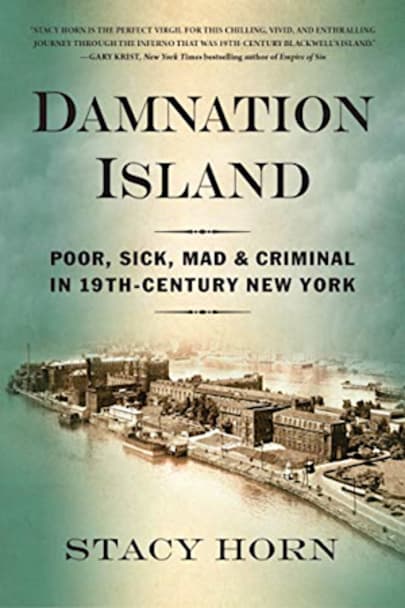“A riveting character-driven dive into 19th-century New York and the extraordinary history of Blackwell’s Island.” –Laurie Gwen Shapiro, author of The Stowaway: A Young Man’s Extraordinary Adventure to Antarctica On a two-mile stretch of land in New York’s East River, a 19th-century horror story was unfolding . . . Today we call it Roosevelt Island. Then, it was Blackwell’s, site of a lunatic … Then, it was Blackwell’s, site of a lunatic asylum, two prisons, an almshouse, and a number of hospitals. Conceived as the most modern, humane incarceration facility the world ever seen, Blackwell’s Island quickly became, in the words of a visiting Charles Dickens, “a lounging, listless madhouse.”
In the first contemporary investigative account of Blackwell’s, Stacy Horn tells this chilling narrative through the gripping voices of the island’s inhabitants, as well as the period’s officials, reformers, and journalists, including the celebrated Nellie Bly. Digging through city records, newspaper articles, and archival reports, Horn brings this forgotten history alive: there was terrible overcrowding; prisoners were enlisted to care for the insane; punishment was harsh and unfair; and treatment was nonexistent.
Throughout the book, we return to the extraordinary Reverend William Glenney French as he ministers to Blackwell’s residents, battles the bureaucratic mazes of the Department of Correction and a corrupt City Hall, testifies at salacious trials, and in his diary wonders about man’s inhumanity to man. In Damnation Island, Stacy Horn shows us how far we’ve come in caring for the least fortunate among us–and reminds us how much work still remains.
more



Another absolutely incredible piece of investigative writing by one of my new favorite authors of non-fiction: Stacy Horn. I’m so thankful she clearly has unique and differing interests, because I’ve now been able to utilize two of her books as research for two completely different projects of my own. Like The Restless Sleep, Horn pulls her readers into the meat of the story on page one. While we have no first-hand accounts in Damnation Island, obviously due to the timeline we’re working with, she keeps us in the thick of it by utilizing personal letters and diaries for storytelling and producing the emotional highs and lows of historical figures, such as Rev. French, one of the main personalities in this book. Horn also utilizes newspapers, which provide not only quotations from a wide cast of characters, but include fantastical descriptions (that are frankly, probably quite accurate) as well as that sort of… dramatic tone and vibe one thinks of when referring to nineteenth century writing.
This is a fascinating deep-dive into the history of New York City and its constant and desperate attempt to separate Us from Them throughout the 1800s. It begins as a story anyone in their right mind can get behind, that being, caring for the sick, the dying, the destitute, and those with mental illnesses, all who cannot care for themselves, especially at a time in history when there was no system, however shaky it might be nowadays, to help them. And with the massive influx of immigrants at this time, New York City was expanding at such a rapid rate, further distancing the rich from the poor, that it became a crisis officials needed to address. Horn’s descriptions of architecture on Blackwell’s Island, initial plans for dorms, baths, housing, and activities for the mentally ill sound like the very best the city could have ever hoped to achieve at the time. Same goes for the concepts behind their Almshouse and the Workhouse. It was always the notion to help those sent to the island to learn new skills and stay out of trouble, or to provide a safe and comfortable place for those too invalid or old to make their way.
The tragedy of the 200 pages that follow is that none of those dreams were achieved. Horn provides an extremely impressive appendix—something she says is only one third of her sources, simply because she couldn’t possibly add it all to the book—and fact-checks the life out of these details in a way that makes my amateur historian heart sing. The names, dates, stories, and tragic deaths of those sent to Blackwell’s that are mentioned in this book might be the first time these people have been remembered in over 150 years. It’s an account that I think every humanitarian non-profit should read. That every employee working for a city or state should read. This is what happened in the past. This is the trauma that thousands lived through and died from. You cannot forget that, you cannot pretend it didn’t happen, but you should want to do better than they did.
A phenomenal piece of work. I think I read the entire book with my jaw hanging open. Bravo, Ms. Horn, and thank you.
The nonfiction DAMNATION ISLAND by Stacy Horn was an eye-opening expose. It was fascinating, binge-worthy and masterfully told. Highly recommended 5-star read.